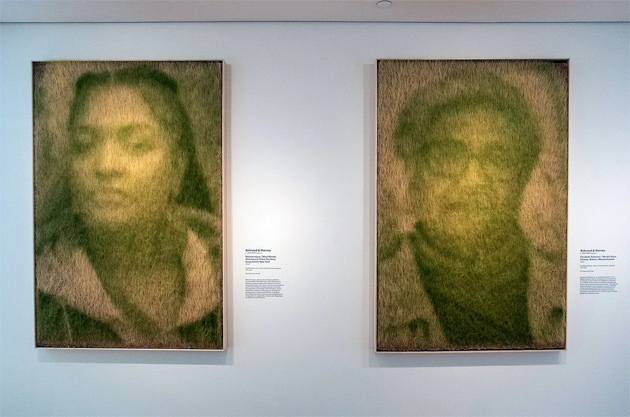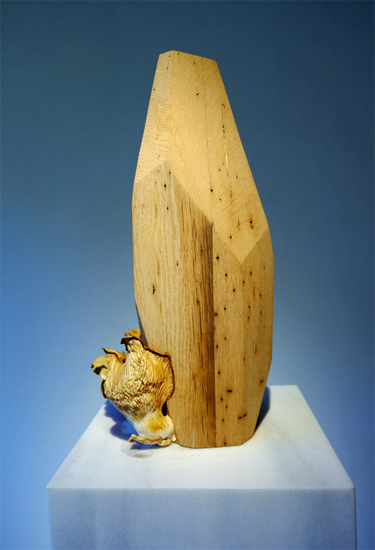Review: Plants invade museum - and art blooms

"Antoine’s Organ'" by Rashid Johnson. See it larger. Photo by Sasha Patkin.
The Isabella Stewart Gardner Museum is one of my favorite museums in Boston, which has to do with its unique history (who doesn't love an unsolved art heist or a quirky female philanthropist?), its hodgepodge and personalized way of displaying art (mixing genres and time periods exactly as Isabella wanted, and mainly unlabelled), its curation of everything from European bench pews to sculptures to personal letters, but most of all its constantly-blooming courtyard garden, which constitutes the heart of museum in every respect.
Although nature is often the inspiration for art, it's hardly ever art in its own right shown within a museum, which is why I wanted to check out the Gardner's latest exhibition, "Presence of Plants in Contemporary Art," which is on view until Sept. 17 and features contemporary art made out of plants.
Photographic photosynthesis portraits by Ackeroyd and Harvey:

Immediately upon entering you are greeted with a dash of green. Two large portraits of women (the captions on the wall identify them as Indigenous activists Netooeusqua and Elizabeth Solomon) are framed on the far wall and composed out of what appears to be grass. These are Heather Ackeroyd and Dan Harvey's works of "photographic photosynthesis" - images grown in seeded grass which emerge in different shades of green relative to how much light exposure they receive.
Detail from Ackeroyd and Harvey’s “The Satanic Formula:"

These pieces look soft; it takes a lot of self-control not to reach out and touch them and try to better understand what they're made of. While they're the color of grass stains and do definitely look plant-like, they're also so painterly that it's almost hard to believe that they're living.
On the opposite wall hangs Ackeroyd and Harvey's piece "The Satanic Formula." It references environmentalist Ranil Senanayake's formula which relates (if I'm summarizing it correctly) the acceleration of climate change by the burning of fossil fuels, and the decreasing amount of oxygen in the air which can only be offset by photosynthesis of leaves and plankton.
As a lover of photography, I was struck by all of these pieces, as well as the quote by Ackeroyd and Harvey on the wall: "Instead of talking about the inherent death in photography we talk about inherent life. … Most photography is about the moment that has been, whereas ours is about being here now."
This gave me pause as I tried to decipher it. Photography does dwell on the past, but it also preserves it and makes it live forever. Ackeroyd and Harvey's work is living, but that means that it must die.
I'm still not sure how to parse those thoughts, but the same kind of inherent contradiction made me pause by "The Satanic Formula," which speaks to how creation and destruction often come hand-in-hand; the plants the piece is composed of offering a solution to the formula they perpetuate.
Piero Golia's Ikebana #3, an oyster mushroom growing on its base:

While I was contemplating all of these big thoughts about the fragility of life and the passage of time, I continued to the end of the narrow room to better observe a small statue on a pedestal: "Ikebana #3" by Piero Golia. An oyster mushroom grew from a carved wooden column, apparently growing and changing over the life of the exhibition and feeding from the art itself.
Like Ackeroyd & Harvey's work, this piece seemed to speak to the nature of life and temporality, but in contrast (perhaps just because of the signage, which indicated that the sculpture was supposed to be an "inversion of our expectations") it initially felt more like a simple critique of traditional art. That is, until a middle-aged lady next to me pulled out her phone and began possibly FaceTiming someone saying something that sounded like: "Dave, meditate on this!"
Weirdly enough, that opened up a whole other dimension of the piece to me. Perhaps Golia's piece was more like a meditation. Is mindfulness and attention what elevates a mushroom from pure existence to art? Is the marble pedestal supposed to remind me of marble statues in other museums, which seek to immortalize their subjects? What is the role of chance and control in art? Does a woman taking a video of an ephemeral mushroom work with or against the exhibition's intention?
At one point another visitor lost the battle I had been internally fighting and let their finger gently graze the mushroom, which elicited a sharp bark from the guard. My meditation grew deeper. If the mushroom is a meditation on a lifecycle and interaction with its environment, isn't human destruction inevitable? Does the guard want to make sure that it is preserved for other visitors, and, in that case, doesn't it just become like all other art, walled off from the common people and the pressing concerns of daily life?
Giving my meditation up as a bad job, I entered the main room, which opened into a flood of sunlight. Rashid Johnson's piece, "Antoine's Organ," is the main draw of the room and perhaps the whole exhibit, perhaps due to its sheer scale, and evoked audible "wows!" from those around me.
The first impression it gives is of a large, open bookcase, like one you might find in an apartment. All of the plants displayed on it are potted, and the shelves are also outfitted with small TVs and various books (the fourth edition of Alcoholics Anonymous, Sellout: The Politics of Racial Betrayal by Randall Kennedy, Ta-Nehisi Coates's Between the World and Me). Not a lot of text accompanied the organ, and I felt a little frustrated that I could not understand it, its intention or its backstory better, but the sight itself was awe-inspiring, and the intricacies of the detail lining the shelves enough to want to walk around it several times.
Pianist Shiyu Fang performs inside "Antoine’s Organ" by Rashid Johnson:
The "organ" hides a piano inside of it, which is hard to see. Text on the wall told me that musicians from local music school partnered with the Isabella Stewart Gardiner museum to animate the work. On the day I visited pianist Shiyu Fang climbed into the sculpture at 1 p.m. and played improvised jazz piano. The music, like the rest of the exhibition, was something living and impermanent and had a lifecycle all its own.
Along the left wall, Henrik Håkansson's piece "A Painting of a Tree" displayed invasive plant cuttings in plastic bottles. Cerith Wyn Evan's piece "In Still Life," took up the other wall, taking the form of a pair of entwined, dappled willow trees slowly rotated on electric turntables while illuminated by spotlights, casting strange perceptions as shadows.
As a good Millennial who loves and collects houseplants and possibly sees them as a stand-in for therapy and the cure for all woes, I was expecting the exhibit to feel more restorative and calming than it actually did. Instead of the feeling of peace that overcomes me when I step out into a forest or a garden, I found myself curiously curated and constrained.
There's a peculiar tension between nature and art when it exists in a museum, where the beauty of nature is at once celebrated in its purest form, and yet also necessarily taken out of context, shrouded in artifice, and subject to curation.
Then I realized that all of the anxiety, curiosity, yearning, and fascination I was feeling was woven into the fabric of the exhibit itself. Ultimately, "Presence of Plants in Contemporary Art" is a thoughtful meditation on nature and all its complexity rather than simply a beautiful arrangement of plants.
That seems fitting for a museum, and particularly for the Isabella Stewart Garder, which is more of a living museum than most - intended, through Isabella's vision, to evoke meaning and emotion through personal association, interdisciplinary performance, and interpretation, rather than didactic explanation.
Like "Antoine's Organ," like the music of the jazz piano, and like every living piece in the room, "Presence of Plants in Contemporary Art" grew, transformed, and sprouted in my own mind, and felt intricately, complicatedly, and definitively alive.
Review from the Independent Review Crew.
Ad:

Comments
Thanks
This is neat. Gonna send this to a few friends who are plant people who would want to go.
Reading the museum notes
Footnote:
Compared to the greenhouse
This is interesting. Yet I wish the Gardner would reopen the greenhouse to the public. Their greenhouse provides a taste of the pleasure that arises from visiting large plant conservatories. In Pittsburgh during the grey months of winter there are lines of people waiting outside to enter the Phipps Conservatory and Botanical Gardens. Whether it is a variation of forest bathing, except in a controlled environment, or simply to spend time in vegetal lushness during the dead of winter, a plant conservatory is wondrous place. Despite a bounty of cultural treasures Boston could be an even richer city if it had a comparable plant conservatory.
At least the Gardner provided a small but still enjoyable substitution via the greenhouse that is part of the new building. Hopefully they will reopen that space to the public.
The Phipps' displays LOOK beautiful...
...but we were even more impressed by the SMELL of the fern room and the tropical orchid room.
Grief and Grievance
I saw Rashid Johnson's piece at an exhibit in New York called "Grief and Greivance". Was the first trip I took to NYC after the lockdowns ended. Powerful in the context of all that.
The Isabella Stewart Gardner
The Isabella Stewart Gardner Museum was always about the music to me. I first heard chamber music there in a honest to god chamber: What an experience! This plant thing looks fantastic. I hope I make it there before everything is composted.